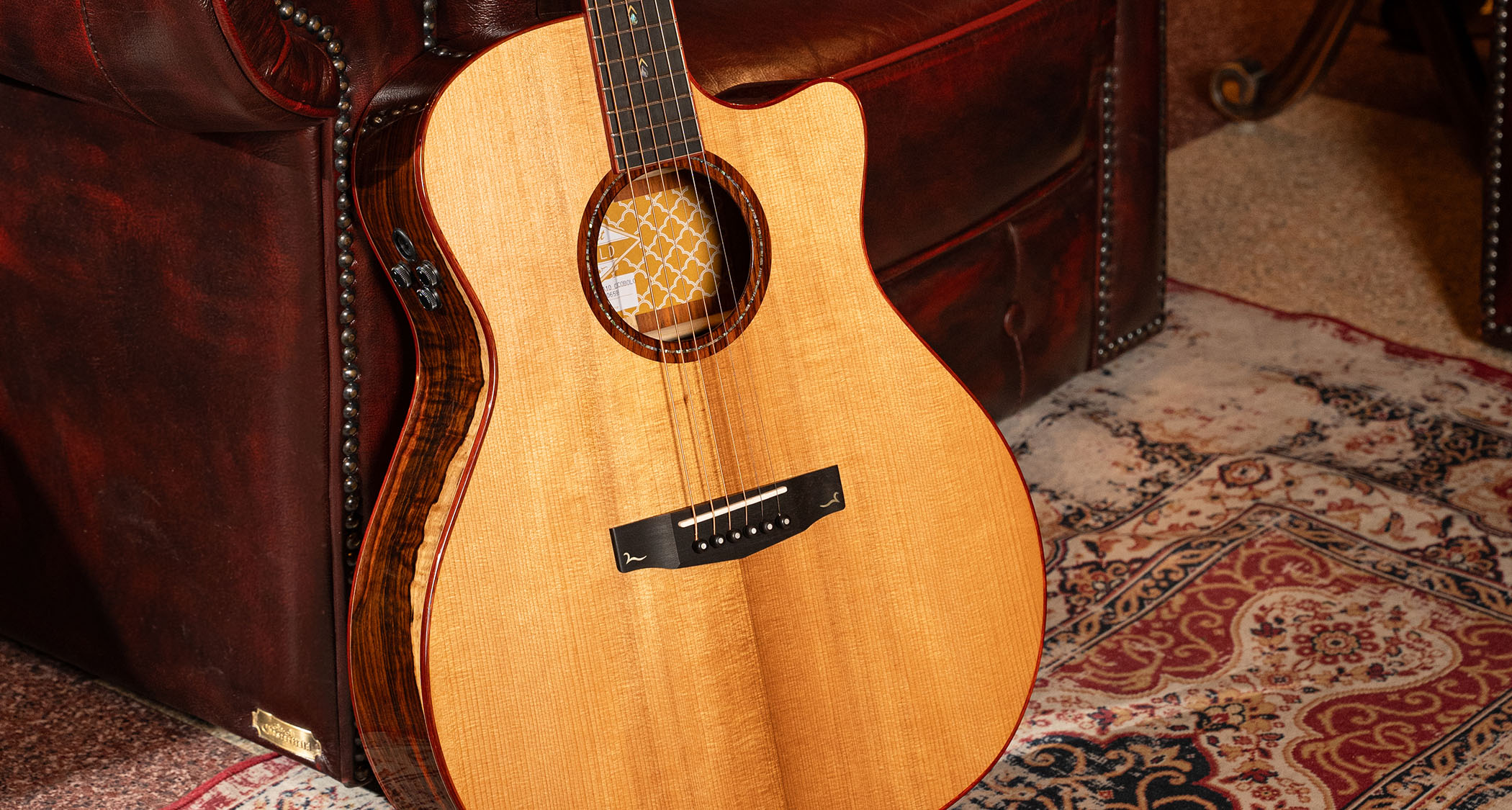The 25 best female blues artists ever
It's not just bluesmen who should be on your stereo
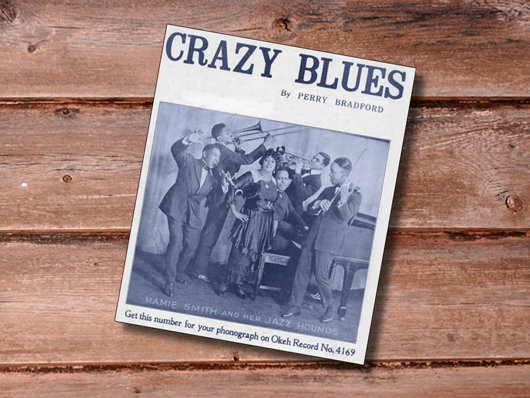
Mamie Smith
‘The Queen of the Blues’ Mamie Smith has the distinction of being the first African-American to record a vocal blues.
Recorded on August 10 1920, Crazy Blues established the now classic lyrical blues theme of tainted love ("The man I love/He don't treat me right/He makes me feel so blue?I don't know what to do’). Mamie put in an incredible, lung-shredding performance on Crazy Blues which became a million seller in less than a year.
Record companies couldn’t ignore sales figures like that. The race was on to find other great female artists of which, it turned out, there was little shortage. The ‘classic female blues’ era had begun…
Listen: Mamie Smith and her Jazz Hounds - Crazy Blues (1920)

Ma Rainey
Female artists owned the blues in the 1920s. That’s fact. Thanks to Mamie Smith, female blues artists were in hot demand and one of the first to make her mark was Ma Rainey, aka the ‘Mother of the Blues.’
Born Gertrude Pridgett in Columbus, Georgia in 1886, Ma Rainey began performing in her early teens and would eventually form the brilliantly monikered Rainey and Rainey, Assassinators of the Blues with her husband William Rainey in 1914.
In 1923, Ma recorded eight songs for Paramount Records in Chicago and a blues legend was born. These tunes included Bo-Weevil Blues and Bad Luck Blues. The following year she cut the classic See See Rider with a young Louis Armstrong on trumpe… or cornet. He played both, y'see…
Listen: Ma Rainey with Louis Armstrong - See See Rider Blues (1924)
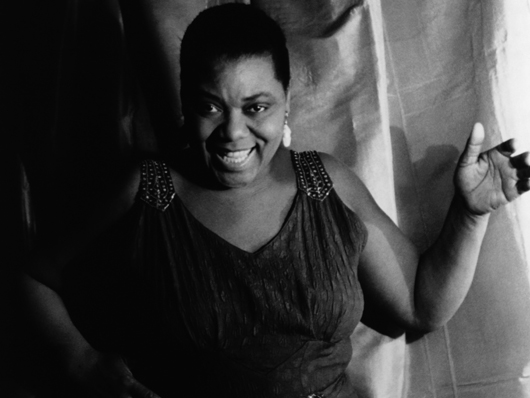
Bessie Smith
No less a legend than Janis Joplin considered Bessie Smith the world’s greatest blues singer. She wasn’t alone in her adulation. Bessie - ‘The Empress of the Blues’ - was the biggest name in blues in the '20s and '30s.
Born in 1892 (or 1894, depending on which source you believe), Bessie began busking on the streets of Chattanooga, Tennessee while still a child. In 1923 she signed with Columbia Records and scored big with her debut release Downhearted Blues shifting a whopping 780,000 copies in just six months.
Bessie died as the result of a car crash in 1937. Despite the earlier fame, her grave remained unmarked until August 7 1970 when a tombstone was finally erected, paid for by Janis Joplin. Sadly, Janis herself died a couple of months later.
Listen: Bessie Smith - Downhearted Blues (1923)
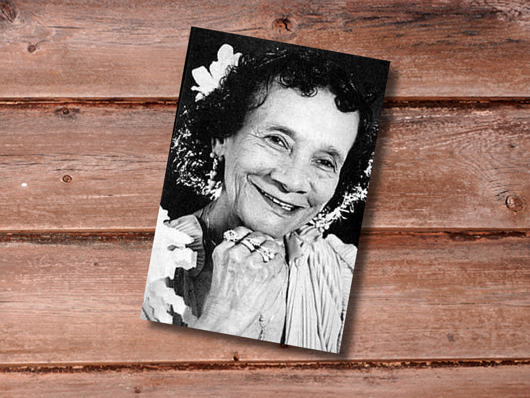
Ida Goodson
What footage does exist of Ida Goodson shows a infectious barrelhouse pianist, singer and ball of energy.
Goodson came from a musical family based in Pensacola, Florida. Her mother and father both played piano as did her sisters Mabel, Della, Sadie, Edna and Wilhemina. Blues was banned in the Goodson household; Ida’s father was a deacon at Pensacola's Mount Olive Baptist Church and had taught his children to play piano for church services and the like. The girls had other ideas and would take turns to keep watch for their parents coming home while the others played the blues.
Ida’s sister Wilhemina would become better known under her stage name of Billie Pierce. She played piano for Bessie Smith in the early '20s. Ida passed away in 2000 but there are still plenty of people out there celebrating the life of an amazing blues musician - see this Ida article on the excellent Piney Flatwoods Girl blog for more.
Listen: Ida Goodson plays and talks about her upbringing
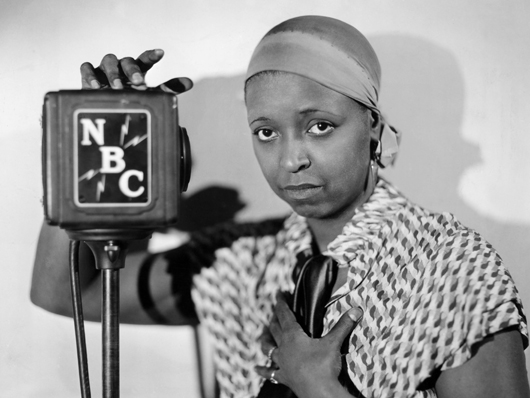
Ethel Waters
Few artists deserved to express the blues more than Ethel Waters.
Born as a result of her mother’s rape, Ethel was never shown any love by her family. She married into what would become an abusive relationship at the age of 13. In a classic frying pan/fire situation she left her husband and would eventually end up falling in love with a drug addict.
None of this real life horror robbed her voice of its immense heart and spirit. She became hugely popular for stirring performances like His Eye Is On The Sparrow and her 1925 recording I’ve Found A New Baby.
Ethel was the first singer to perform the standard Stormy Weather. She debuted the tune in 1933 at The Cotton Club in Harlem.
Listen: Ethel Waters - His Eye Is On The Sparrow
Listen: Ethel Waters - I’ve Found A New Baby (1925)
Listen: Ethel Waters - Stormy Weather (1933)
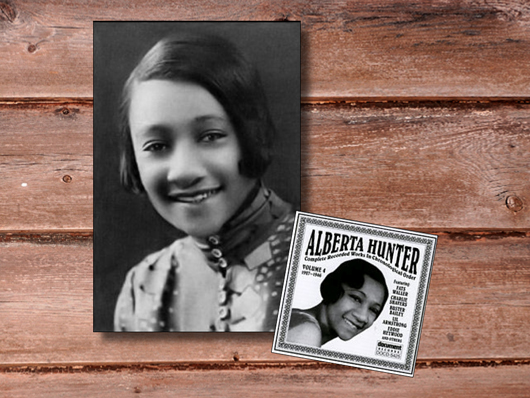
Alberta Hunter
Born in Memphis, Tennessee in 1895 Alberta Hunter enjoyed an amazing 40 year career as an entertainer, then gave it up to become a nurse in the mid-50s.
In 1977, at the age of 82, she staged a successful comeback and proved that she’d lost none of her fire or her infectious sense of humour. Her hilarious performance of Two-Fisted, Double-Jointed, Rough and Ready Man (audio below) is priceless.
Early in her career Alberta scored big when she co-wrote Downhearted Blues, the million selling record that launched Bessie Smith’s career. The song would later be covered by blues and jazz royalty like Son House, Cab Minnie The Moocher’ Calloway and Ella Fitzgerald.
While a hard copy is tough to find, clips of the 2001 documentary of Alberta’s life My Castle’s Rockin‘ are available to eyeball on YouTube - click here for nine priceless minutes. We dare you not to fall in love with this amazing character.
Listen: Alberta Hunter - Two-Fisted, Double-Jointed, Rough and Ready Man (live at The Smithsonian in 1981)
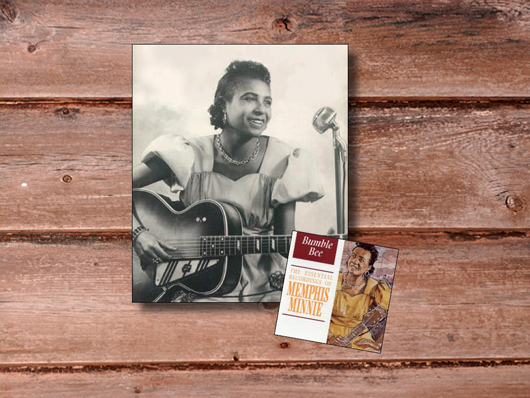
Lizzie 'Memphis Minnie' Douglas
Man, Memphis Minnie was terrifying! Hard as nails, Minnie could play guitar just about better than anyone and was no pushover in the tough juke joints and blues clubs. As legendary slide guitarist Johnny Shines once recalled: Any men fool with her she’d go for them right away. She didn’t take no foolishness off them…
She didn’t show her fellow guitarists any mercy either. Cuttin’ heads with blues guitar legends Big Bill Broonzy and Tampa Red at a club in Chicago, Minnie tore them both a new one, earning their respect in the process. Her prowess on guitar is legendary and she could sing up a storm, but she was also a great songwriter. She co-wrote When The Levee Breaks with her then husband Kansas Joe McCoy in 1929. The song was later re-worked by… Well, you know the rest - and if you don't, click here!
If you’re keen to find out more about this female blues icon, Paul and Beth Garon’s book Woman with Guitar: Memphis Minnie's Blues is a great place to go next.
Listen: Lizzie 'Memphis Minnie' Douglas - I'd Rather See Him Dead (1938)

Victoria Spivey
Born in Houston, Texas in 1906, Victoria Spivey’s favourite sources of lyrical inspiration were disease and shagging… and not necessarily in that order. What did you think Organ Grinder Blues and her 1926 hit Black Snake Blues were all about?
Like Alberta Hunter, Spivey retired from performing and recording in the 50s. In Victoria’s case it wasn’t the call of nursing but playing organ in church that temporarily halted her career. She re-emerged in the early 60s. Her cheeky 1963 live performance of TB Blues (listen below) proved that she’d lost none of her presence.
Incidentally, her 1962 albums recorded with Big Joe Williams (Three Kings And The Queen/Three Kings And The Queen Volume Two) featured some bloke called Bob Dylan on harmonica and backing vocals…
Listen: Victoria Spivey with the Clarence Williams Blue Five - Organ Grinder Blues (1929)
Listen: Victoria Spivey - Black Snake Blues/No More Jelly Beans (1926)
Listen: Victoria Spivey with Willie Dixon - TB Blues (live, 1963)
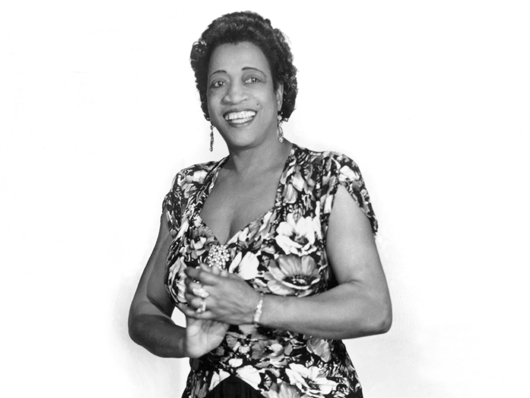
Ida Cox
Mamie Smith was the ‘Queen of the Blues' but Ida Cox was known as ‘The Uncrowned Queen of the Blues.’
Coronation issues aside, Ida was a terrific performer and one of the greatest singers of the classic female blues period. Often billed in the pre-politically correct 1920s as the Sepia Mae West, Ida recorded some fantastic sides including the chilling Coffin Blues and her still shocking, racially charged 1930 release What Did I Do To Be So Black And Blue.
After several years in retirement Ida was persuaded to record one last album in the 60s with the Coleman Hawkins Quintet. The result is a treat for fans of old school blues ballads and torch songs. The album can be downloaded from Amazon here.
Listen: Ida Cox - Coffin Blues (1925)
Listen: Ida Cox - What Did I Do To Be So Black And Blue (1930)
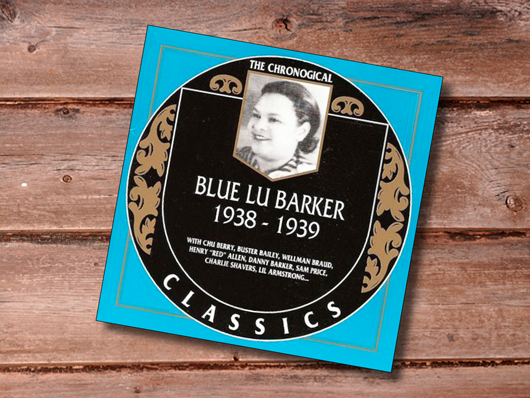
Blue Lu Barker
Blue Lu Barker (or Louise Dupont according to her birth certificate) may have had a limited vocal range but that didn’t stop her influencing one of the greatest singers of all time. Blue Lu Barker was my biggest influence, Billie Holiday once confirmed.
The fact is that Barker’s records were great. Her brilliantly saucy 1938 classic Don’t You Feel My Leg offers some good advice to potential suitors! It’s not quite up there in filth terms with Lucille Bogan’s Shave ‘Em Dry but it’s definitely naughty.
Blue Lu’s other great work, the swinging A Little Bird Told Me is a doozy. It’s an infectious performance - check the audio clip below. We can’t stop listening to it and nor will you…
Listen: Blue Lu Barker - Don’t You Feel My Leg
Listen: Blue Lu Barker - A Little Bird Told Me
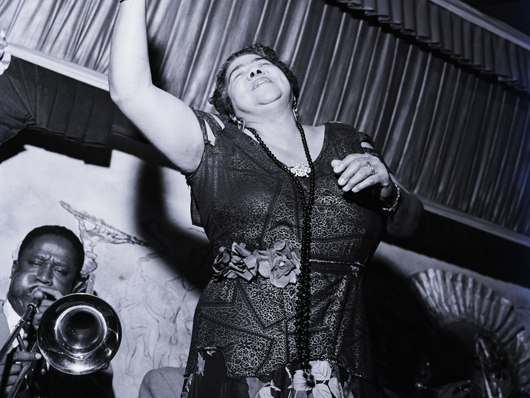
Lizzie Miles
Like many African-American singers of the 20s and beyond, Lizzie Miles would be torn between staying respectful to her love of God and performing the blues, seen by many at the time as the Devil’s Music.
After a number of years out of the limelight following a serious illness, Lizzie was persuaded to perform again. Thing is, she had vowed in prayer not to perform onstage ever again if she was saved from the illness. So, for the rest of her career she would perform on the floor in front of, or beside, the stage.
Born Elizabeth Mary Landreaux in 1895, Lizzie didn’t like to be defined as a blues singer, preferring to be known as a performer of many different styles. Songs like the tough blues of Salty Dog and the Creole jazz of Eh La Bas demonstrate her formidable range and skills.
Listen: Lizzie Miles with Sharkey Bonano in 1952 - Salty Dog (1952)
Listen: Lizzie Miles with Bob Scobey - Eh La Bas (1956)
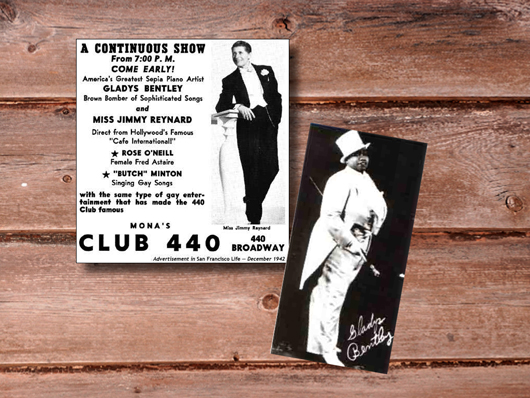
Gladys Bentley
While many of the classic female blues artists of the 20s were accompanied by quartets or small orchestras - in a style that’s as much jazz as it is blues - Gladys Bentley often performed with a sparse backing… she could do a mean trumpet impression!
An amazing character, Gladys was openly gay and often dressed in men’s clothes, usually a tuxedo and top hat. She obviously enjoyed courting controversy; she performed in front of a chorus line of drag queens and once claimed to have married a white woman.
But it’s Gladys's incredible piano chops and belting vocal style that made her a legend of the blues. She demonstrated both when she appeared on Groucho Marx’s You Bet Your Life TV show in the 50s. Click here for an amazing if bizarre YouTube clip - strange clip, awesome performance…
Listen: Gladys Bentley accompanied by Eddie Lang (guitar) - Wild Geese Blues (1928)
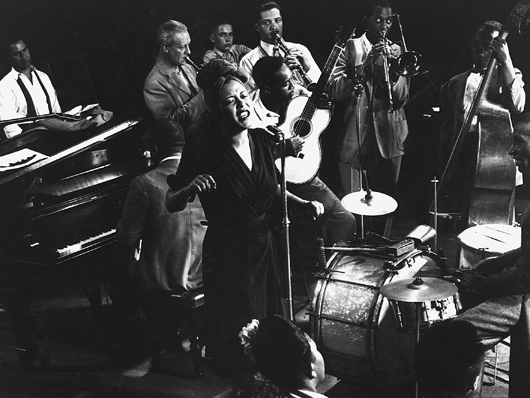
Billie Holiday
While Elinore Harris, better known as Billie Holiday, is usually associated with jazz music but she was heavily influenced by the classic female blues era singers, Blue Lu Barker in particular. Besides, what was her iconic performance of Strange Fruit, a harrowing song about the lynching of blacks in the Deep South, if it wasn’t blues?
Also known as ‘Lady Day’ and the ‘Queen of Song’ she didn’t have the greatest vocal range but it’s what she did with her voice that made her a legend. Billie’s improvised style echoed the delivery of jazz musicians and her troubled life, documented in the book Lady Sings The Blues, gave her music an emotion depth far beyond any notions of technical ability.
A genius, plain and simple.
Listen: Billie Holiday - Strange Fruit (live)
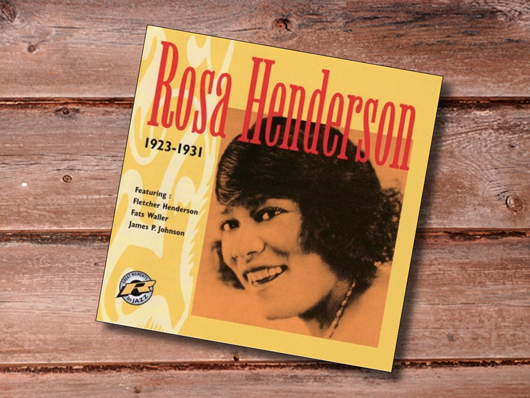
Rosa Henderson
Rosa Henderson excelled at those mournful ‘my man done me wrong’ blues. A great case in point is Nobody Knows The Way I Feel ‘Dis Mornin’ recorded in February 1925.
Rosa would record around 100 songs under a variety of pseudonyms that included Flora Dale, Sally Ritz, Sarah Johnson and Mamie Harris. Her career went into decline and she would eventually take a job in a department store in the early 30s.
While she would perform live again she never recorded another song. It’s a shame because she was a great vocalist and records like If You Don’t Give Me What I Want from 1923 and Don’t Advertise Your Man, cut a year later, are now highly respected and sought after.
Listen: Rosa Henderson - Nobody Knows The Way I Feel ‘Dis Mornin’ (1925)
Listen: Rosa Henderson with Fletcher Henderson (piano) - If You Don’t Give Me What I Want (1923)
Listen: Rosa Henderson with the Kansas City Five - Don’t Advertise Your Man (1925)
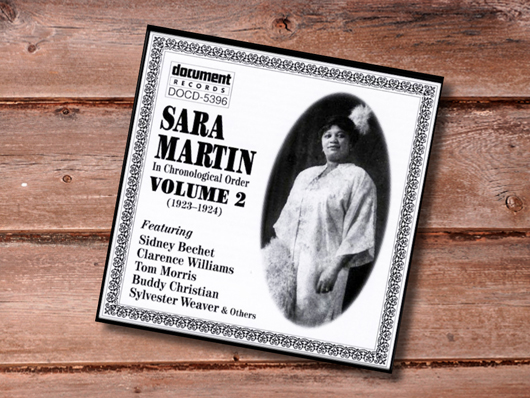
Sara Martin
Although Sara Martin’s recorded performances can vary in quality she deserves her place in this exalted company thanks to killer sides like her 1928 classic Death Sting Me Blues backed by King Oliver’s Orchestra. This is deep funereal blues with references to cocaine and whiskey. Don’t press play if you’re having a bad day.
Known as ‘The Famous Moanin' Mama’ Sara would also perform under the names Margaret Johnson and Sally Roberts. Like many of her peers she recorded prolifically in the 20s - with the likes of Fats Waller and Eva Taylor’s husband Clarence Williams - only to retire from music shortly afterwards as the classic female blues era ended. She went on to run a nursing home.
Listen: Sara Martin with King Oliver's Orchestra - Death Sting Me Blues (1928)

Bertha 'Chippie' Hill
Born in Charleston, North Carolina in 1905, Bertha ‘Chippie’ Hill would begin her career as a dancer before crossing paths with fellow blues singers Ethel Waters and Ma Rainey on the club circuit.
She settled in Chicago in 1925 and began recording for the Okeh label that same year. Hill’s hauntingly spare 1926 recording of Pratt City Blues features Louis Armstrong on cornet. She would record other tracks with Satchmo and later duets with Lonnie Johnson (the first guitarist to play single string guitar solos) and slide guitarist, Tampa Red.
In a now familiar career pattern to readers of this feature, Chippie retired from music in the 1930s but staged a comeback in 1946 becoming a success on the jazz scene. Unfortunately, her career was cut short when she was knocked down and killed by a car in 1950.
Listen: Bertha 'Chippie' Hill with Louis Armstrong - Pratt City Blues (1926)
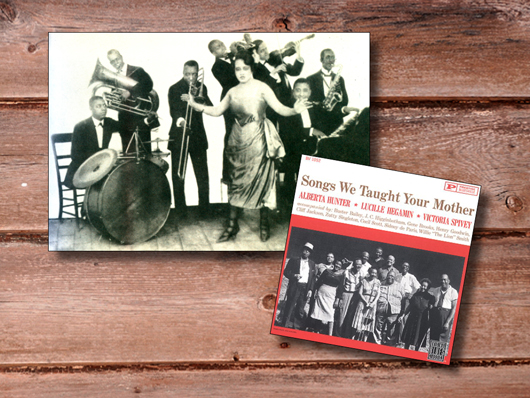
Lucille Hegamin
One of the more obscure characters of the classic female blues era, Lucille Hegamin was actually the second African-American artist to release a blues record. She was just pipped to the post by Mamie Smith.
Like Smith, Lucille sang in a frothier pop style than the women who would follow in her footsteps like Ma Rainey and Bessie Smith. Lucille’s stand out recordings include You May Be Fast But Mamma's Gonna Slow You Down and her slightly naughty 1922 hit He May Be Your Man But He Comes To See Me Sometime. Ah, how she loved those long song titles…
Lucille retired from the music scene in 1934 to take up nursing but like many blues artists she popped back up on the radar in the '60s when the blues revival took hold.
Listen: Lucille Hegamin - You May Be Fast But Mamma's Gonna Slow You Down
Listen: Lucille Hegamin and her Blue Flame Syncopators - He May Be Your Man But He Comes To See Me Sometime (1925)
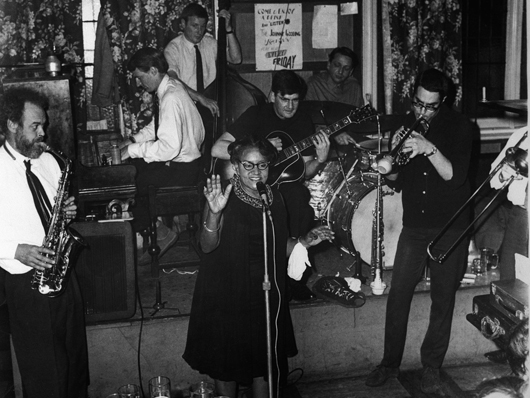
Eva Taylor
Known as ‘The Dixie Nightingale’ Eva Taylor was a blues and jazz singer. Born Irene Joy Gibbons in St Louis, Missouri in 1895, Eva began her career as a performer at the age of three and had toured a fair part of the world before she hit her teens.
Eva recorded her first blues record for the black owned Black Swan Records in 1922. Fellow blues artists Alberta Hunter, Lucille Hegamin and Ethel Waters would also record for the label. Eva’s nightingale tag was spot on. Her attractive warbling vocal style made her a hit with record buyers of the day.
Her performance on the Ragtime-style Candy Lips backed by her husband, pianist Clarence Williams, recorded in 1926 is typical of her crystal clear delivery. Eva knocked music on the head in the 40s but began touring again in the 60s and 70s following her husband’s death. She died in 1977.
Listen: Eva Taylor with the Clarence Williams Blue Seven - Candy Lips (1926)
Listen: Eva Taylor - Sugar Blues (rare - live on Swedish TV show Huset, 1975)
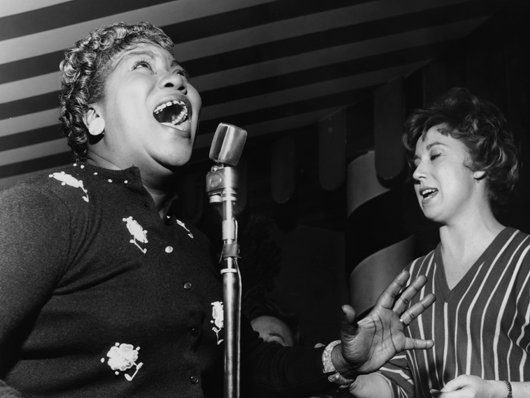
Sister Rosetta Tharpe
Although best known as a gospel artist Rosetta Tharpe’s rollicking mix of blues and jazz marked her out as a pioneer of rock 'n' roll. She was Johnny Cash’s favourite singer whilst Little Richard idolised her too. Rosetta was also a huge influence on Elvis Presley, Jerry Lee Lewis and Aretha Franklin.
She was born Rosetta Nubin in Cotton Plant, Arkansas in 1915 and made her stage debut at four years old. Billed as ‘Little Rosetta Nubin, the singing and guitar playing miracle’ she performed with her Evangelist mother. Rosetta recorded her first sides on October 31 1938. Her later 1944 recording Strange Things Happening Every Day is a stone classic and obvious forerunner of rock n roll. Rosetta’s picked intro is righteous stuff.
Listen: Sister Rosetta Tharpe - Strange Things Happening Every Day (1944)
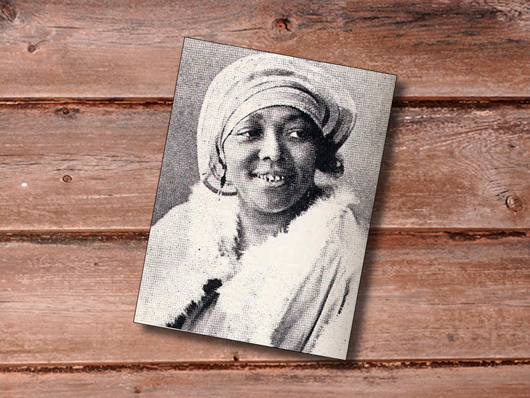
Lucille Bogan
We covered Mississippi sauce pot Lucille in our recent A-Z of blues - she was lurking in the X for X-rated entry, the minx…
Lucille’s infamous 1935 recording of Shave ‘Em Dry, accompanied by pianist Walter Roland, deserves a generous mouthful of soap but it is a great performance. The sexual frankness evident in the song was born out of Lucille’s tough stints in rough clubs and juke joints.
The subject matter of her songs was based on the drinking and whoring she witnessed every night. Lucille was just singing about what she knew about... which is what the blues is about after all. Here endeth the lesson!
Listen: Lucille Bogan - Shave ‘Em Dry (1935)
Listen: Lucille Bogan - They Ain't Walking No More (1930)
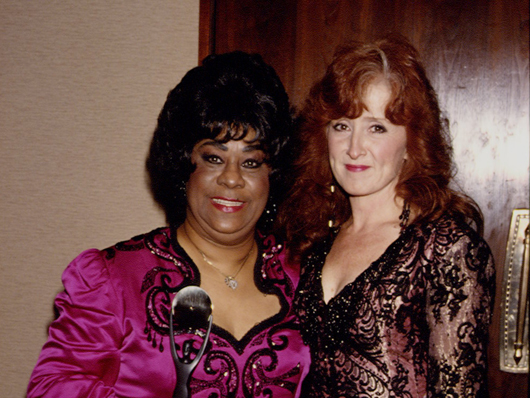
Ruth Brown
Best known as a pop and R&B singer Ruth Brown had the soul of a blues shouter.
Between 1949, when she recorded her first success So Long, to 1955, Ruthy scored 16 top ten hits for Atlantic Records. Five of those records were number ones. She was so successful that Atlantic Records was called ‘The House That Ruth Built.‘
In the 60s, Ruth retired from the music business to become a housewife and raise a family. She returned to music in 1975, firing on all cylinders.
A huge influence on Bonnie Raitt, Ruth was inducted into the Rock and Roll Hall of Fame as the ‘Queen Mother of the Blues’ in 1993. Her mastery of blues is demonstrated beautifully in her playful 1993 duet with BB King on Ain’t Nobody’s Business. Listen below - and then expand to full-screen to watch and learn from two masters of the blues…
Listen: Ruth Brown and BB King - Ain’t Nobody’s Business (live at The Blues Summit Concert,1993)
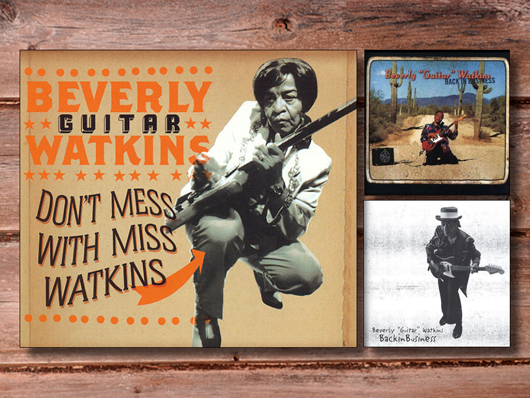
Beverly 'Guitar' Watkins
"People are impressed to see a black woman play like a man," once said Atlanta, Georgia’s Beverly ‘Guitar’ Watkins. It’s sad that people still have to make that distinction because Watkins is just a great guitarist, and vocalist, full stop.
A professional musician since the late 1950s, Beverly worked with the likes of BB King and James Brown but never achieved breakthrough success for herself. After falling off the radar in the 80s, she bounced back in 1999 with a brilliant album, aptly titled Back In Business. Watching her wring notes from a red Fender Mustang on the album’s title track is a real treat (click here to see her in action).
Asked to about her style Beverly described it as "real Lightnin' Hopkins lowdown blues. I would call that hard classic blues, hard stompin' blues, you know... railroad smokin' blues!" Amen to that.
Listen: Beverly 'Guitar' Watkins - Back In Business (live on the Winston Blues Revival tour, 1999)
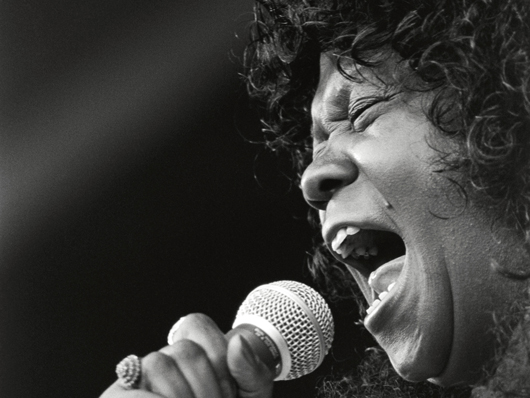
Koko Taylor
Born Cora Walton, Koko Taylor was the other ‘The Queen of the Blues.’ Even among the illustrious talent assembled for this feature Koko was special.
Inspired by blues pioneers like Ma Rainey and Bessie Smith, Koko ripped into songs like Wang Dang Doodle with abandon and she knew the blues inside out (click here for proof). Koko began her career singing in Chicago blues clubs in the late 50s. Spotted by blues performer, and prolific songwriter, Willie Dixon in 1962, she would eventually sign to Chess Records in 1965.
Up to her death in 2009 at the age of 80 Koko was still playing 70 gigs a year. Among her many great achievements in her later career was a cameo in David Lynch’s warped 1990 classic Wild At Heart.
Listen: Koko Taylor with Little Walter - Wang Dang Doodle (live, 1967)
Listen: Koko Taylor - I Cried Like A Baby (TV documentary rip)
Listen: Koko Taylor - Up In Flames (taken from Wild At Heart)
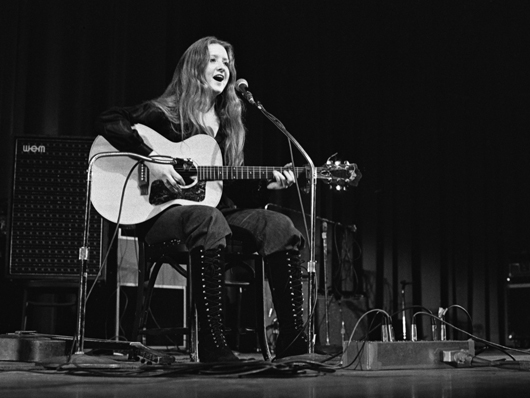
Bonnie Raitt
While some of the names in this feature will be unknown to all but the most fanatical blues fiend, everyone knows who Bonnie Raitt is.
A brilliant slide guitarist and vocalist, Raitt played alongside legends like Howlin’ Wolf and Mississippi Fred McDowell on the 60s club scene before signing a record contract with Warner Bros in 1970. Her self-titled 1971 debut album established her as a serious blues artist with killer guitar chops.
Her tenth album, 1989’s Nick of Time, was a smash hit selling six million copies. One of Raitt’s finest moments came when she made a guest appearance on blues deity John Lee Hooker’s 1989 album The Healer. The sultry I’m In The Mood was a brilliant showcase for Bonnie’s slide guitar work. John Lee wasn’t too dusty on the track either.
Listen: John Lee Hooker and Bonnie Raitt - I’m In The Mood (1989)

Rory Block
A master of the country blues, Rory Block has immersed herself in the work of Delta icon Robert Johnson. Anyone who has ever tried to walk down to that crossroads will know that Johnson’s songs are not a cinch to play. Remember: Keith Richards of The Rolling Stones thought he was listening to a deuce of guitarists when he first caught Johnson’ recordings.
On her 2006 album The Lady and Mr Johnson, Rory plays and sings through 13 Robert Johnson classics like Walking Blues, Rambling On My Mind, Last Fair Deal Gone Down and Cross Roads Blues. Her performance on the latter is a masterclass in country blues.
If you fancy having a go yourself, grab a guitar and a slide and check out this lesson on YouTube. Still interested? Check out Rory’s own tuition DVDs at over at Homespun - click here and tell 'em we sent ya…
Listen: Rory Block - Cross Roads Blues (live at the Happy Days Visitors Center, Ohio, 2007)
Liked this? Now read: A-Z of the blues
Connect with MusicRadar: via Twitter, Facebook and YouTube
Get MusicRadar straight to your inbox: Sign up for the free weekly newsletter
“I’m looking forward to breaking it in on stage”: Mustard will be headlining at Coachella tonight with a very exclusive Native Instruments Maschine MK3, and there’s custom yellow Kontrol S49 MIDI keyboard, too
“The thing from the agency said, ‘We want a piece of music that is inspiring, universal, blah-blah, da-da-da...' and at the bottom it said 'and it must be 3 & 1/4 seconds long’“: Brian Eno’s Windows 95 start-up sound added to the US Library of Congress
“I’m looking forward to breaking it in on stage”: Mustard will be headlining at Coachella tonight with a very exclusive Native Instruments Maschine MK3, and there’s custom yellow Kontrol S49 MIDI keyboard, too
“The thing from the agency said, ‘We want a piece of music that is inspiring, universal, blah-blah, da-da-da...' and at the bottom it said 'and it must be 3 & 1/4 seconds long’“: Brian Eno’s Windows 95 start-up sound added to the US Library of Congress









